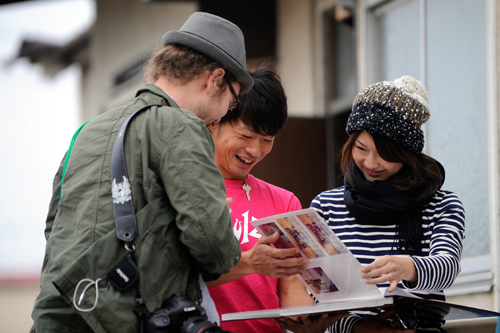Photohoku

|
Can you explain a little about your work that acted as the basis for Photohoku and how that evolved into Photohoku? Photohoku’s origins are in Tokyo Kids Photo, a business where international photographers would take portraits of families with children—I was the representative director in that office. We were taking tons of family portraits of everything from shrine visits and the 7-5-3 festivals to everyday images. In Tokyo Kids Photo, professional photographers would conduct the work and when the families received the photographs, they would just light up, as if these were one of life’s treasures. I saw a lot of that so when the Tohoku earthquake happened, I asked about the conditions in the disaster areas. Sure enough, many families lost their photo albums and I thought that maybe we could bring some joy back to their lives by giving them new albums. For Photohoku in the beginning, I basically wanted to do in Tohoku what I was doing for Tokyo Kids Photo. That was all. But then when I started to visit the disaster areas, my fellow partner Brian Scott Peterson (interviewed in the previous issue) pointed out, ‘we should take photographs with instant film because then we can give them a present right on the spot.’ And not just photographs—albums, too, were washed away, so right before we left we bought a bunch of them. Then we realized that people had lost their cameras. From inside our car, we posted on Facebook, asking people to donate cameras. This project, then, started from my idea, but Brian was the one who pushed it forward, and now we have Photohoku. Can you describe how you got Fuji Film involved in Photohoku? When we did a workshop for Tokyo Kids Photo, we got some support from Fuji Film and so I asked that point person if we couldn’t also get some film for Photohoku. We just wanted film that was close to expiring or that had already expired if they had it. I asked for just enough to take about 100 shots for Photohoku and enough for more than 5000 arrived! What other corporate sponsors were you able to get supplies and/or funding from? -Albums from Nakabayashi Corporation Brian said one of your roles is to act as an interface between Photohoku and the communities. Can you explain? Yes, one of my roles is to coordinate things on the ground. So for example if we just walk right up to some temporary housing units without advanced notice, they might think we’re up to something suspicious and all kinds of trouble can happen. So I first let the manager or city hall know and in most cases I do have to submit some kind of form. The method and process changes from place to place. Then you have ‘tatemae’ (public face) and ‘honne’ (true position), and other very distinct Japanese cultural protocol that you have to navigate. Since I’m Japanese, I handle all that. Also, since we are outsiders, so to speak, I need to look for people on the ground up there who will cooperate and help us build relationships. I also handle recontacting families we have met and photographed. What are some of the challenges you are seeing from the logistics side? The biggest issue for us is financing. Right now, all of our members are volunteers and all the money for our activities has come through donations. In order to continue, we rely on people’s generosity. Put another way, if people didn’t care, we’d have to stop what we are doing. While people are still living in temporary housing (the government initially predicted three years), I want to maintain this pace. To that end, we do collect funds through charity events and fight to keep going. Maintaining people’s interest in the project is tough, too. With every day that passes since the disaster, people’s interest wanes. Both our volunteers and media coverage have dwindled. I think this is probably natural, but there are still so many people living in temporary shelters that can’t leave and a slew of problems that they still face. Even some of the survivors fret and tell me, “I feel like we may be forgotten.” To prevent this from happening, at Photohoku we take a positive approach, run events and exhibitions, and work hard to convey the conditions of the disaster areas. What’s your vision for Photohoku’s future? My ultimate goal is to conduct Photohoku activities beyond just the disaster areas. For example, we’d like to visit child cancer centers and give photographs to families there. For kids, simply meeting international photographers may bring giddiness, surprise or shyness. I think that has something to do with their very foreign presence being something special and outside the norm for them. While playing with the kids, we take pictures of them with family members they might not be able to spend all their time with, and give them those photos. Even when we are gone, those photographs will remain. So when the kids get lonely because they can’t see certain family members, they can look at those photographs. And when mothers and fathers and grandparents can’t see the kids and feel lonely, they too can look at the photographs. I want to provide that connection between families. We actually even had inquiries from people overseas who wanted to conduct these activities at facilities or marginalized places in their own countries. I’d be overjoyed to see Photohoku thrive not just in disaster areas, but in an array of places all over the world. |
Photohokuシリーズの第2部として、吉川優子さんのインタビューを掲載します。 第1部ではPhotohokuの共同創立者であるブライアン・ピーターソンさんを特集しました。 あなたがPhotohokuで果たした役割について、少しお聞かせください。 また、Photohokuの活動はどのように発展していったのでしょうか。 Photohokuの原点はTokyo Kids Photoにあります。Tokyo Kids Photoとは、外国人カメラマンがこどものいる家族写真を撮影する写真事務所で私が代表を務めています。お宮参りや七五三等の行事から日常の様子までたくさんの家族写真を撮影しています。Tokyo Kids Photoでプロが撮った家族写真を、一生の宝ものだと喜んでくださる家族の方々をたくさん見てきたので、東日本大震災が起きて被災地の状況を聞いた時に、きっと写真を失くした被災者の方々の新しい家族写真をプレゼントしたら喜んでもらえるのではないかと考えました。 当初のPhotohokuは、Tokyo Kids Photoでやっていたことを東北でやりたい。というだけのものでした。しかし初めて被災地に訪問する際、同行したブライアン・ピーターソンが「インスタントフィルムで撮影した方がその場でプレゼントしていいのでは」と提案してくれました。また、写真だけでなくアルバムも流されているはずなので、アルバムも買っていこうと出発前にアルバムを購入しました。更にはカメラも失くしているはずだということに気づき、車の中からFacebookで皆にカメラの寄付を呼びかけました。初めは私の想いからスタートしましたが、それをブライアンが進化させてくれ、今のPhotohokuがあります。 富士フィルム社が、Photohokuに関わったいきさつはどのようなものだったのでしょうか。 Tokyo Kids Photoでワークショップをした際、富士フィルム社にフィルムを支援していただいたことがあり、その担当者の方にPhotohoku用にフィルムを支援してもらえないかお願いしました。期限が迫っているものや、期限切れフィルムなどの在庫があれば100枚程Photohokuで活用させて欲しいとお願いしたところ、5000枚以上のフィルムが届きました。 他の企業からは、どのような支援を受けていますか。 -ナカバヤシ株式会社よりアルバム提供 ブライアン・ピーターソンは、Photohokuとコミュニティを繋ぐことがあなたの役割のひとつだと話してくれましたが、詳しく教えてください。 私の役割のひとつは、現地との調整役です。例えば仮設住宅に許可なく勝手に伺うと、不審者だと思われますし、色々とトラブルになります。管理人の方や市役所などに事前に知らせ、書類を提出するケースがほとんどです。その方法や手順は場所によって異なる上、建前と本音など日本独特の文化を汲み取らなければいけないことも多く、日本人である私が引き受けています。また私たちは外部の人間なので、現地で協力してくれる方を探して関係構築を図ったり、一度訪問した家族に連絡を取って再会できるよう調整したりしています。 後方支援の面からみて、今後必要と思われるものは何ですか? 一番の課題は、資金繰りです。現在、参加メンバーは全員ボランティア、活動資金は全て寄付で成り立っています。活動が続けられているのは、皆さんの善意によるものです。逆を言えば、皆さんの関心が無くなれば、活動が続けられなくなってしまいます。仮設住宅に人が住んでいる間(当初の政府発表では3年間)は、今のペースで活動を続けたいと思っているので、自分達でもチャリティーイベントを行って資金を稼ぐなど、活動継続のために挑戦しています。 人々の関心を向かせ続けるのも難しいです。震災から時日が経つにつれ、人々の関心は明確に薄れてきています。ボランティアの数やメディアの量も減っています。自然な流れだと思いますが、未だに仮設住宅から抜け出せない人が多く、問題が山積みなのは変わっていません。被災者の方々も「忘れられてしまう」ということに危機感をもっていると話してくれました。このことを風化させないためにも、Photohokuではイベントや展示会を積極的に行い、被災地のことを伝えるよう務めています。 Photohokuの将来の目標は? 私の目標は、Photohokuの活動を、被災地以外の場所でも行っていきたいということです。例えば小児がんセンターに訪問し、そこで家族写真を撮ってプレゼントしたいです。子どもたちは、外国人カメラマンに会うだけでもはしゃいだり、驚いたり、恥ずかしがったりと色々な反応を見せてくれます。それは外国人という存在が非日常でスペシャルだからだと思います。外国人カメラマンがパッチアダムスのように、子どもを楽しませながら撮影をして、普段ずっと一緒にいれない家族との写真をプレゼントしたいです。私たちが去った後も写真は残るので、子ども達は家族と会えなくて寂しい時に写真を見ることができるし、家族も愛する子どもに会えなくて寂しい時に、写真を見ることができる。そんな家族の橋渡しができればと思っています。実際に海外の方から、Photohokuの活動を自国の施設や限界集落などで行いたい、と問合せが来たともありました。被災地だけではなく、様々な施設やそれこそ世界にPhotohokuが広がっていけば嬉しいです。 |








